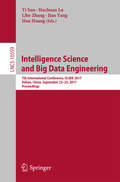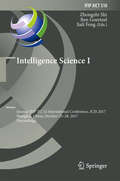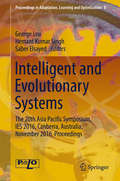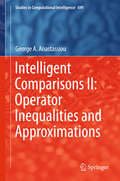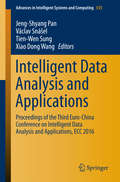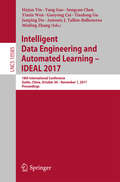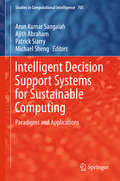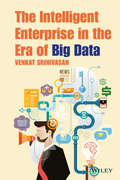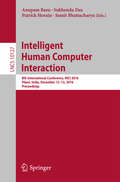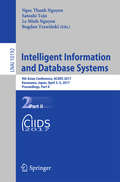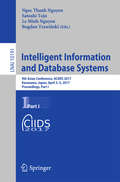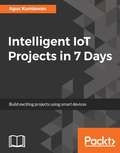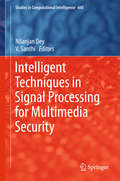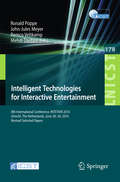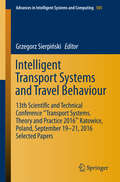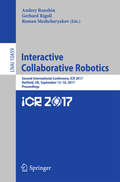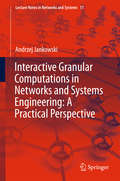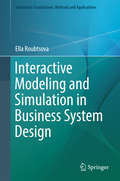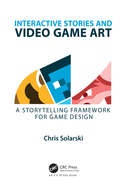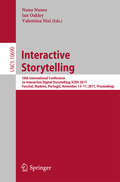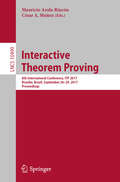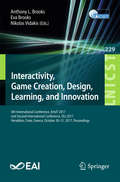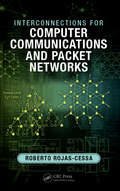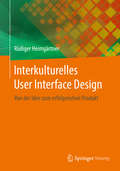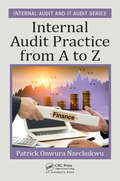- Table View
- List View
Intelligence Science and Big Data Engineering: 7th International Conference, IScIDE 2017, Dalian, China, September 22-23, 2017, Proceedings (Lecture Notes in Computer Science #10559)
by Yi Sun, Huchuan Lu, Lihe Zhang, Jian Yang and Hua HuangThis book constitutes the proceedings of the 7th International Conference on Intelligence Science and Big Data Engineering, IScIDE 2017, held in Dalian, China, in September 2017.The 48 full papers and 14 short papers presented in this volume were carefully reviewed and selected from 121 submissions. They deal with statistics and learning; deep neural networks; faces and people; objects; classification and clustering; imaging; biomedical signal processing; and recommendation.
Intelligence Science I: Second IFIP TC 12 International Conference, ICIS 2017, Shanghai, China, October 25-28, 2017, Proceedings (IFIP Advances in Information and Communication Technology #510)
by Zhongzhi Shi, Ben Goertzel and Jiali FengThis book constitutes the refereed proceedings of the Second International Conference on Intelligence Science, ICIS 2017, held in Shanghai, China, in October 2017.The 38 full papers and 9 short papers presented were carefully reviewed and selected from 82 submissions. They deal with key issues in intelligence science and have been organized in the following topical sections: theory of intelligence science; cognitive computing; big data analysis and machine learning; machine perception; intelligent information processing; and intelligent applications.
Intelligent and Evolutionary Systems
by George Leu Hemant Kumar Singh Saber ElsayedOver the last two decades the field of Intelligent Systems delivered to human kind significant achievements, while also facing major transformations. 20 years ago, automation and knowledge-based AI were still the dominant paradigms fueling the efforts of both researchers and practitioners. Later, 10 years ago, statistical machine intelligence was on the rise, heavily supported by the digital computing, and led to the unprecedented advances in and dependence on digital technology. However, the resultant intelligent systems remained designer-based endeavors and thus, were limited in their true learning and development abilities. Today, the challenge is to have in place intelligent systems that can develop themselves on behalf of their creators, and gain abilities with no or limited supervision in the tasks they are meant to perform. Cognitive development systems, and the supporting cognitive computing are on the rise today, promising yet other significant achievements for the future of human kind. This book captures this unprecedented evolution of the field of intelligent systems, presenting a compilation of studies that covers all research directions in the field over the last two decades, offering to the reader a broad view over the field, while providing a solid foundation from which outstanding new ideas may emerge.
Intelligent Comparisons II: Operator Inequalities and Approximations
by George A. AnastassiouThis compact book focuses on self-adjoint operators' well-known named inequalities and Korovkin approximation theory, both in a Hilbert space environment. It is the first book to study these aspects, and all chapters are self-contained and can be read independently. Further, each chapter includes an extensive list of references for further reading. The book's results are expected to find applications in many areas of pure and applied mathematics. Given its concise format, it is especially suitable for use in related graduate classes and research projects. As such, the book offers a valuable resource for researchers and graduate students alike, as well as a key addition to all science and engineering libraries.
Intelligent Data Analysis and Applications
by Jeng-Shyang Pan Václav Snášel Tien-Wen Sung Xiao Dong WangThis book gathers papers presented at the ECC 2016, the Third Euro-China Conference on Intelligent Data Analysis and Applications, which was held in Fuzhou City, China from November 7 to 9, 2016. The aim of the ECC is to provide an internationally respected forum for scientific research in the broad areas of intelligent data analysis, computational intelligence, signal processing, and all associated applications of artificial intelligence (AI). The third installment of the ECC was jointly organized by Fujian University of Technology, China, and VSB-Technical University of Ostrava, Czech Republic. The conference was co-sponsored by Taiwan Association for Web Intelligence Consortium, and Immersion Co. , Ltd.
Intelligent Data Engineering and Automated Learning – IDEAL 2017: 18th International Conference, Guilin, China, October 30 – November 1, 2017, Proceedings (Lecture Notes in Computer Science #10585)
by Hujun Yin, Yang Gao, Songcan Chen, Yimin Wen, Guoyong Cai, Tianlong Gu, Junping Du, Antonio J. Tallón-Ballesteros and Minling ZhangThis book constitutes the refereed proceedings of the 18th International Conference on Intelligent Data Engineering and Automated Learning, IDEAL 2017, held in Guilin, China, in October/November 2017.The 65 full papers presented were carefully reviewed and selected from 110 submissions. These papers provided a sample of latest research outcomes in data engineering and automated learning, from methodologies, frameworks and techniques to applications. In addition to various topics such as evolutionary algorithms, deep learning neural networks, probabilistic modelling, particle swarm intelligence, big data analytics, and applications in image recognition, regression, classification, clustering, medical and biological modelling and prediction, text processing and social media analysis.
Intelligent Decision Support Systems for Sustainable Computing
by Arun Kumar Sangaiah Ajith Abraham Patrick Siarry Michael ShengThis unique book dicusses the latest research, innovative ideas, challenges and computational intelligence (CI) solutions in sustainable computing. It presents novel, in-depth fundamental research on achieving a sustainable lifestyle for society, either from a methodological or from an application perspective. Sustainable computing has expanded to become a significant research area covering the fields of computer science and engineering, electrical engineering and other engineering disciplines, and there has been an increase in the amount of literature on aspects sustainable computing such as energy efficiency and natural resources conservation that emphasizes the role of ICT (information and communications technology) in achieving system design and operation objectives. The energy impact/design of more efficient IT infrastructures is a key challenge in realizing new computing paradigms. The book explores the uses of computational intelligence (CI) techniques for intelligent decision support that can be exploited to create effectual computing systems, and addresses sustainability problems in computing and information processing environments and technologies at the different levels of CI paradigms. An excellent guide to surveying the state of the art in computational intelligence applied to challenging real-world problems in sustainable computing, it is intended for scientists, practitioners, researchers and academicians dealing with the new challenges and advances in area.
The Intelligent Enterprise in the Era of Big Data
by Venkat SrinivasanAn innovative guide to the organization and function of enterprises in the technological age In the era of big data and automation, this book presents a cutting-edge approach in how enterprises should organize and function. Striking a practical balance between theory and practice, The Intelligent Enterprise in the Era of Big Data presents an enterprise architecture that embodies the power of the emerging technology environment. Beginning with an introduction to the key challenges that enterprises face, the book systematically outlines a modern enterprise architecture through a detailed discussion of the inseparable elements of such an architecture: efficiency, flexibility, and intelligence. This architecture enables rapid responses to market needs by facilitating intelligent, flexible automation of enterprise business processes and sensing important developments in internal and external environments in near real time. Illustrating all of these elements in an integrated fashion, The Intelligent Enterprise in the Era of Big Data also features: A detailed discussion on issues of time-to-market and flexibility with respect to enterprise application technology Novel analyses illustrated through extensive real-world case studies to help readers better understand the applicability of the architecture and concepts Practical approaches for designing and building intelligent enterprises An appendix that presents various approaches to text analysis with real-world business implications The Intelligent Enterprise in the Era of Big Data is an appropriate reference for business executives, information technology professionals, data scientists, and management consultants.
Intelligent Human Computer Interaction
by Anupam Basu Sukhendu Das Patrick Horain Samit BhattacharyaThis book constitutes the proceedings of the 8th International Conference on Intelligent Human Computer Interaction, IHCI 2016, held in Pilani, India, in December 2016. The 22 regular papers and 3 abstracts of invited talks included in this volume were carefully reviewed and selected from 115 initial submissions. They deal with intelligent interfaces; brain machine interaction; HCI applications and technology; and interface and systems.
Intelligent Information and Database Systems: 9th Asian Conference, ACIIDS 2017, Kanazawa, Japan, April 3–5, 2017, Proceedings, Part II (Lecture Notes in Computer Science #10192)
by Ngoc Thanh Nguyen, Satoshi Tojo, Le Minh Nguyen and Bogdan TrawińskiThe two-volume set LNAI 10191 and 10192 constitutes the refereed proceedings of the 9th Asian Conference on Intelligent Information and Database Systems, ACIIDS 2017, held in Kanazawa, Japan, in April 2017. The total of 152 full papers accepted for publication in these proceedings was carefully reviewed and selected from 420 submissions. They were organized in topical sections named: Knowledge Engineering and Semantic Web; Social Networks and Recommender Systems; Text Processing and Information Retrieval; Intelligent Database Systems; Intelligent Information Systems; Decision Support and Control Systems; Machine Learning and Data Mining; Computer Vision Techniques; Advanced Data Mining Techniques and Applications; Intelligent and Context Systems; Multiple Model Approach to Machine Learning; Applications of Data Science; Artificial Intelligence Applications for E-services; Automated Reasoning and Proving Techniques with Applications in Intelligent Systems; Collective Intelligence for Service Innovation, Technology Opportunity, E-Learning and Fuzzy Intelligent Systems; Intelligent Computer Vision Systems and Applications; Intelligent Data Analysis, Applications and Technologies for Internet of Things; Intelligent Algorithms and Brain Functions; Intelligent Systems and Algorithms in Information Sciences; IT in Biomedicine; Intelligent Technologies in the Smart Cities in the 21st Century; Analysis of Image, Video and Motion Data in Life Sciences; Modern Applications of Machine Learning for Actionable Knowledge Extraction; Mathematics of Decision Sciences and Information Science; Scalable Data Analysis in Bioinformatics and Biomedical Informatics; and Technological Perspective of Agile Transformation in IT organizations.
Intelligent Information and Database Systems: 9th Asian Conference, ACIIDS 2017, Kanazawa, Japan, April 3-5, 2017, Proceedings, Part I (Lecture Notes in Computer Science #10191)
by Ngoc Thanh Nguyen, Satoshi Tojo, Le Minh Nguyen and Bogdan TrawińskiThe two-volume set LNAI 10191 and 10192 constitutes the refereed proceedings of the 9th Asian Conference on Intelligent Information and Database Systems, ACIIDS 2017, held in Kanazawa, Japan, in April 2017. The total of 152 full papers accepted for publication in these proceedings was carefully reviewed and selected from 420 submissions.They were organized in topical sections named: Knowledge Engineering and Semantic Web; Social Networks and Recommender Systems; Text Processing and Information Retrieval; Intelligent Database Systems; Intelligent Information Systems; Decision Support and Control Systems; Machine Learning and Data Mining; Computer Vision Techniques; Advanced Data Mining Techniques and Applications; Intelligent and Context Systems; Multiple Model Approach to Machine Learning; Applications of Data Science; Artificial Intelligence Applications for E-services; Automated Reasoning and Proving Techniques with Applications in Intelligent Systems; Collective Intelligence for Service Innovation, Technology Opportunity, E-Learning and Fuzzy Intelligent Systems; Intelligent Computer Vision Systems and Applications; Intelligent Data Analysis, Applications and Technologies for Internet of Things; Intelligent Algorithms and Brain Functions; Intelligent Systems and Algorithms in Information Sciences; IT in Biomedicine; Intelligent Technologies in the Smart Cities in the 21st Century; Analysis of Image, Video and Motion Data in Life Sciences; Modern Applications of Machine Learning for Actionable Knowledge Extraction; Mathematics of Decision Sciences and Information Science; Scalable Data Analysis in Bioinformatics and Biomedical Informatics; and Technological Perspective of Agile Transformation in IT organizations.
Intelligent IoT Projects in 7 Days
by Agus KurniawanDiscover how to build your own Intelligent Internet of Things projects and bring a new degree of interconnectivity to your world. About This Book • Build intelligent and unusual IoT projects in just 7 days, • Create home automation, smart home, and robotic projects and allow your devices to do smart work • Build IoT skills through enticing projects and leverage revolutionary computing hardware through the RPi and Arduino. Who This Book Is For If you're a developer, IoT enthusiast, or just someone curious about Internet of Things, then this book is for you. A basic understanding of electronic hardware, networking, and basic programming skills would do wonders. What You Will Learn • Learn how to get started with intelligent IoT projects • Explore various pattern recognition and machine learning algorithms to make IoT projects smarter. • Make decisions on which devices to use based on the kind of project to build. • Create a simple machine learning application and implement decision system concepts • Build a smart parking system using Arduino and Raspberry Pi • Learn how to work with Amazon Echo and to build your own smart speaker machine • Build multi-robot cooperation using swarm intelligence. In Detail Intelligent IoT Projects in 7 days is about creating smart IoT projects in just 7 days. This book will help you to overcome the challenge of analyzing data from physical devices. This book aims to help you put together some of the most exciting IoT projects in a short span of time. You'll be able to use these in achieving or automating everyday tasks—one project per day. We will start with a simple smart gardening system and move on to a smart parking system, and then we will make our own vending machine, a smart digital advertising dashboard, a smart speaker machine, an autonomous fire fighter robot, and finally look at a multi-robot cooperation using swarm intelligence Style and approach A clear step-by-step instruction guide to completing fully-fledged projects in just 7 days
Intelligent Techniques in Signal Processing for Multimedia Security
by Nilanjan Dey V. SanthiThis book proposes new algorithms to ensure secured communications and prevent unauthorized data exchange in secured multimedia systems. Focusing on numerous applications' algorithms and scenarios, it offers an in-depth analysis of data hiding technologies including watermarking, cryptography, encryption, copy control, and authentication. The authors present a framework for visual data hiding technologies that resolves emerging problems of modern multimedia applications in several contexts including the medical, healthcare, education, and wireless communication networking domains. Further, it introduces several intelligent security techniques with real-time implementation. As part of its comprehensive coverage, the book discusses contemporary multimedia authentication and fingerprinting techniques, while also proposing personal authentication/recognition systems based on hand images, surveillance system security using gait recognition, face recognition under restricted constraints such as dry/wet face conditions, and three-dimensional face identification using the approach developed here. This book equips perception technology professionals with the latest technologies, techniques, and strategies for multimedia security systems, offering a valuable resource for engineers and researchers working to develop security systems.
Intelligent Technologies for Interactive Entertainment
by Ronald Poppe John-Jules Meyer Remco Veltkamp Mehdi DastaniThis book constitutes the refereed proceedings of the 8th International Conference on Intelligent technologies for Interactive Entertainment, INTETAIN 2016, held in Utrecht, The Netherlands, in June 2016. The 19 full papers, 5 short and 6 workshop papers were selected from 49 submissions and present novel interactive techniques and their application in entertainment, education, culture and art. The papers are grouped in six thematic sessions: serious games, novel applications and tools, exertion games, persuasion and motivation, interaction technologies and game studies.
Intelligent Transport Systems and Travel Behaviour
by Grzegorz SierpińskiDoes application of countdown timers at traffic lights affect pedestrian safety? How can one model walking routes in transport systems using open source tools? What features should be particularly taken into account while implementing highly advanced ICT components in contemporary towns? What scenario for the development of Intelligent Transport Systems should be chosen for a specific area? How to estimate the impact of the substances emitted by vehicles on climate changes? Answers to these and many other questions can be found in this publication. It also comprises numerous analyses based on legitimate data sources, presenting the close relation between travel behaviours and the organisational as well as technical changes introduced in what is contemporarily referred as smart cities. At present and in the nearest future, technologically advanced transport systems require and will require considerable development of electromobility and the emphasis being placed on multimodality, therefore all these problems have been properly addressed in this publication. With regard to the research results discussed and the selected solutions which find practical application, the publication is dedicated to three groups of recipients: . Scientists and researchers (ITS field) . Local authorities (responsible for the transport system on the urban and the regional level) . Representatives of business (traffic strategy management) and industry (manufacturers of ITS components). The publication entitled Intelligent Transport Systems and Travel Behaviour contains selected papers submitted to and presented at the 13th Transport Systems. Theory and Practice Scientific and Technical Conference organised by the Department of Transport Systems and Traffic Engineering at the Faculty of Transport of the Silesian University of Technology. The conference was held on 19-21 September 2016 in Katowice (Poland). More details at www. TSTP. polsl. pl "
Interactive Collaborative Robotics
by Andrey Ronzhin Gerhard Rigoll Roman MeshcheryakovThis book constitutes the proceedings of the Second International Conference on Interactive Collaborative Robotics, ICR 2017, held in Hatfield, UK, in September 2017, as a satellite event of the 19th International Conference on Speech and Computer, SPECOM 2017. The 30 papers presented in this volume were carefully reviewed and selected from 51 submissions. This new conference invites researchers in the area of social robotics and collaborative robotics to share experience in human-machine interaction research and development of robotic and cyberphysical systems. Topics addressed are: assistive robots, child-robot interaction, collaborative robotics, educational robotics, human-robot interaction, medical robotics, robotic mobility systems, robots at home, robot control and communication, social robotics, as well as safety robot behavior.
Interactive Granular Computations in Networks and Systems Engineering: A Practical Perspective
by Andrzej JankowskiThe book outlines selected projects conducted under the supervision of the author. Moreover, it discusses significant relations between Interactive Granular Computing (IGrC) and numerous dynamically developing scientific domains worldwide, along with features characteristic of the author's approach to IGrC. The results presented are a continuation and elaboration of various aspects of Wisdom Technology, initiated and developed in cooperation with Professor Andrzej Skowron. Based on the empirical findings from these projects, the author explores the following areas: (a) understanding the causes of the theory and practice gap problem (TPGP) in complex systems engineering (CSE); (b) generalizing computing models of complex adaptive systems (CAS) (in particular, natural computing models) by constructing an interactive granular computing (IGrC) model of networks of interrelated interacting complex granules (c-granules), belonging to a single agent and/or to a group of agents; (c) developing methodologies based on the IGrC model to minimize the negative consequences of the TPGP. The book introduces approaches to the above issues, using the proposed IGrC model. In particular, the IGrC model refers to the key mechanisms used to control the processes related to the implementation of CSE projects. One of the main aims was to develop a mechanism of IGrC control over computations that model a project's implementation processes to maximize the chances of its success, while at the same time minimizing the emerging risks. In this regard, the IGrC control is usually performed by means of properly selected and enforced (among project participants) project principles. These principles constitute examples of c-granules, expressed by complex vague concepts (represented by c-granules too). The c-granules evolve with time (in particular, the meaning of the concepts is also subject of change). This methodology is illustrated using project principles applied by the author during the implementation of the POLTAX, AlgoTradix, Merix, and Excavio projects outlined in the book.
Interactive Modeling and Simulation in Business System Design
by Ella RoubtsovaThis book explores the process of interactive modeling and interactive simulation. The text covers several modeling techniques that are used in the interactive cycle of modeling and simulation. There are two tendencies in modern business that increase the role of executable modeling and simulation as tools of business development and intelligence. Firstly, there are no business processes that remain unchanged for a long time. The initial requirement of simulation that the model has been developed is difficult to fulfil. In practice, the model should be often modified and extended. Secondly, modern business processes involve the human-computer communication. For those systems, the model should contain means for interaction with humans, and the modeling and simulation becomes interactive. This second tendency makes the models even more changeable as the contact of a human with models stimulates human creativity.
Interactive Stories and Video Game Art: A Storytelling Framework for Game Design
by Chris SolarskiThe success of storytelling in games depends on the entire development team—game designers, artists, writers, programmers and musicians, etc.—working harmoniously together towards a singular artistic vision. Interactive Stories and Video Game Art is first to define a common design language for understanding and orchestrating interactive masterpieces using techniques inherited from the rich history of art and craftsmanship that games build upon. Case studies of hit games like The Last of Us, Journey, and Minecraft illustrate the vital components needed to create emotionally-complex stories that are mindful of gaming’s principal relationship between player actions and video game aesthetics. This book is for developers of video games and virtual reality, filmmakers, gamification and transmedia experts, and everybody else interested in experiencing resonant and meaningful interactive stories. Key Features: The first book to define a common visual and interactive language for understanding and orchestrating sophisticated stories in video games Accessible to industry professionals as well as non-developers Featured concepts apply to all media with an interactive component including: transmedia, gamification and interactive art The definitive framework for designing interactive stories
Interactive Storytelling: 10th International Conference on Interactive Digital Storytelling, ICIDS 2017 Funchal, Madeira, Portugal, November 14–17, 2017, Proceedings (Lecture Notes in Computer Science #10690)
by Nuno Nunes, Ian Oakley and Valentina NisiThis book constitutes the refereed proceedings of the 10th International Conference on Interactive Digital Storytelling, ICIDS 2017, held in Funchal, Madeira, Portugal, in November 2017. The 16 revised full papers and 4 short papers presented were carefully reviewed and selected from 65 submissions. The papers are organized in topical sections on story design, location and generation, history and learning, games, emotion and personality, posters and demos.
Interactive Theorem Proving
by Mauricio Ayala-Rincón César A. MuñozThis book constitutes the refereed proceedings of the 8th International Conference on Interactive Theorem Proving, ITP 2017, held in Brasilia, Brazil, in September 2017. The 28 full papers, 2 rough diamond papers, and 3 invited talk papers presented were carefully reviewed and selected from 65 submissions. The topics range from theoretical foundations to implementation aspects and applications in program verification, security and formalization of mathematical theories.
Interactivity, Game Creation, Design, Learning, and Innovation: 5th International Conference, Artsit 2016, And First International Conference, Dli 2016, Esbjerg, Denmark, May 2-3, 2016. Proceedings (Lecture Notes of the Institute for Computer Sciences, Social Informatics and Telecommunications Engineering #196)
by Nikolas Vidakis Eva Brooks Anthony L. BrooksThis book constitutes the proceedings of two conferences: The 6th International Conference on ArtsIT, Interactivity and Game Creation (ArtsIT 2017) and the Second International Conference on Design, Learning and Innovation (DLI 2017). The event was hosted in Heraklion, Crete, Greece, in October 2017 and attracted 65 submissions from which 50 full papers were selected for publication in this book. The papers represent a forum for the dissemination of cutting-edge research results in the area of arts, design and technology, including open related topics like interactivity and game creation.
Interconnections for Computer Communications and Packet Networks
by Roberto Rojas-CessaThis book introduces different interconnection networks applied to different systems. Interconnection networks are used to communicate processing units in a multi-processor system, routers in communication networks, and servers in data centers. Queuing techniques are applied to interconnection networks to support a higher utilization of resources. There are different queuing strategies, and these determine not only the performance of the interconnection network, but also the set of requirements to make them work effectively and their cost. Routing algorithms are used to find routes to destinations and directions in what information travels. Additional properties, such as avoiding deadlocks and congestion, are sought. Effective routing algorithms need to be paired up with these networks. The book will introduce the most relevant interconnection networks, queuing strategies, and routing algorithm. It discusses their properties and how these leverage the performance of the whole interconnection system. In addition, the book covers additional topics for memory management and congestion avoidance, used to extract higher performance from the interconnection network.
Interkulturelles User Interface Design
by Rüdiger HeimgärtnerDieses Fachbuch beschreibt den Weg der Entwicklung eines international nutzbaren Produktes mit Mensch-Maschine-Schnittstelle von der Theorie über die Konzeption und Gestaltung bis hin zur praktischen Umsetzung. Es werden die wichtigsten Konzepte in den Bereichen Philosophie, Kommunikation, Kultur und Ethnocomputing als Grundlage des interkulturellen User Interface Designs erläutert. Der Autor präsentiert direkt nutzbares handlungsrelevantes Wissen für die Prozesse der Internationalisierung und Lokalisierung von Software. Das Werk ist für ein allgemeines Publikum geschrieben, das sich für Softwareergonomie, Softwareengineering und das menschzentrierte Design im interkulturellen Kontext interessiert. Für Produktmanager und Usability Professionals sind die konkreten Empfehlungen und Checklisten für die direkte Umsetzung in der Produktgestaltung von besonderem Interesse.
Internal Audit Practice from A to Z (Security, Audit and Leadership Series)
by Patrick Onwura NzechukwuInternal Audit Practice from A to Z addresses the practice of internal auditing using GAAS (Generally Accepted Auditing Standards), GAGAS (Generally Accepted Government Auditing Standards) and International Standards for the Professional Practice of Internal Auditing (Standards)-IPPF, International Standards Organization (ISO), International Standards of Supreme Audit Institutions (ISSAI), International Standards on Auditing (ISA) as enunciated by the Institute of Internal Auditors (IIA), International Organization of Standardizations (ISO), International Organization of Supreme Audit Institutions (INTOSAI), Government Accountability Office (GAO) & International Federation of Accountants (IFAC). Unique in that it is primarily written to guide internal auditors in the process and procedures necessary to carry out professionally accepted internal audit functions, the book includes everything necessary to start, complete, and evaluate an internal audit practice, simplifying the task for even non-professionals. Internal Audit Practice from A to Z features A rich array of forms, figures, tables, and reports, making it a practical, hands-on book Provides comprehensive content that contains all the practical guidance necessary to start, complete, and evaluate an internal audit practice Details on how to ensure quality on internal audit function through peer review Current international standards for the professional practice of internal auditing and other relevant standards for reference Checklists for all practice procedures as well as a checklist of the internal control of virtually all aspects of business function A blend of professional practice with theory. Internal Audit Practice from A to Z is comprehensively rich, global reference is a must for public, private, NGOs, institutions—every organization.
